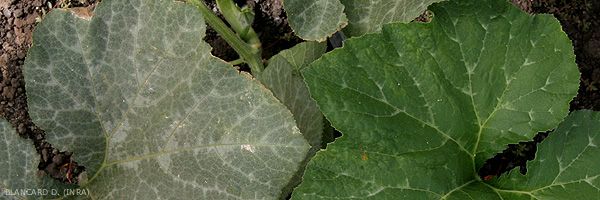
Squash silvering
This physiological disorder is induced by the parasitic activity of nymphs and adults of the whitefly Bemisia tabaci (Genn.) Biotype B , also known as B. argentifolii Bellows & Perring (Figure 1). Other whitefly biotypes have been locally associated with this disorder on Cucurbits (Indian Ocean and Africa). This disease (not to be confused with physiological macules ) was observed in the 1960s in Israel, and in the 1980s in the southern United States (Florida) and the Middle East. It has accompanied the spread of this whitefly in the world and is now manifesting itself in many countries. It was first observed in France in the early 1990s.
The feeding behavior of whiteflies and the production of a toxin is the cause of the leaf discolorations observed (Figures 2 and 3). The veins first (Figure 4), then the other parts of the leaf blade turn yellow and gradually take on a silvery tint (Figure 5). Quickly large leaf sectors, then whole leaves show a silver color (figure 6). Note that the appearance of the underside of the leaves remains unchanged. In a situation of strong expression of silvering, the color of the fruits is altered; they are brighter, of poorer quality, and yields are reduced.
The 3 main species Cucurbita cultivated can show silvering symptoms: C. pepo , C. maxima and C. moschata , but also wild species like C. ecuadorensis and C. martinezii . Nevertheless, differences in sensitivity to the silvering have been observed in species Cucurbita . Cucumber, melon and watermelon are not affected.
Remember that B. argentifolii is a very destructive pest attacking many crops located in open fields, especially in the tropics and subtropics of the world, but also in glasshouses. The heavy infestations of whiteflies and the feeding activities of this insect have repercussions on the physiological processes of the parasitized plants, reducing transpiration, photosynthesis, and their growth. To this should be added its influence on the development of sooty mold (altering photosynthesis and marketed products), but also its role as a vector of several dozen more or less formidable viruses in different regions of the world.
Controlling this problem involves controlling whitefly populations. If they are subdued, the newly formed leaves will be normal, while the affected leaves will remain so. Note that some varieties of zucchini are resistant to silvering.





